How a music industry pronoun dataset unpacks gender equity

VALERIE MACON // AFP via Getty Images
How a music industry pronoun dataset unpacks gender equity
The music industry has long been a mirror of cultural identity and expression, but its reflection of equality has remained distorted. To answer the question of who is visible in today’s music industry, and who is not, Chartmetric launched the Make Music Equal report, the industry’s only pronoun dataset and identity tracker. The project exists as three parts:
- Publicly Available Dataset. A free and fully accessible database of more than 1 million artist pronouns across the world.
- State of the Industry Tracker. A live dashboard about the current state of diversity in music.
- Artist Identification Tool. Ability to check and verify an artist’s pronoun data.
What is the Pronoun Dataset?
Rather than assigning gender to artists, the dataset relies on the pronouns that artists and their teams include in their bios on digital streaming platforms. This has grown into a database of over 1 million pronouns.
This data is used to analyze pronoun distribution across genres, playlists, and charts, aiming to highlight the industry’s gender disparities and identify where improvements are most needed.
The 2025 Report
Released in tandem with the dataset, tracker, and ongoing identification initiative, the 2025 report aims to address the current state of gender equity across different sectors in music. It’s important to note that while pronouns often align with gender identity, they are not synonymous.
This analysis, based on pronoun usage, is an imperfect step toward understanding and addressing gender equity in music.
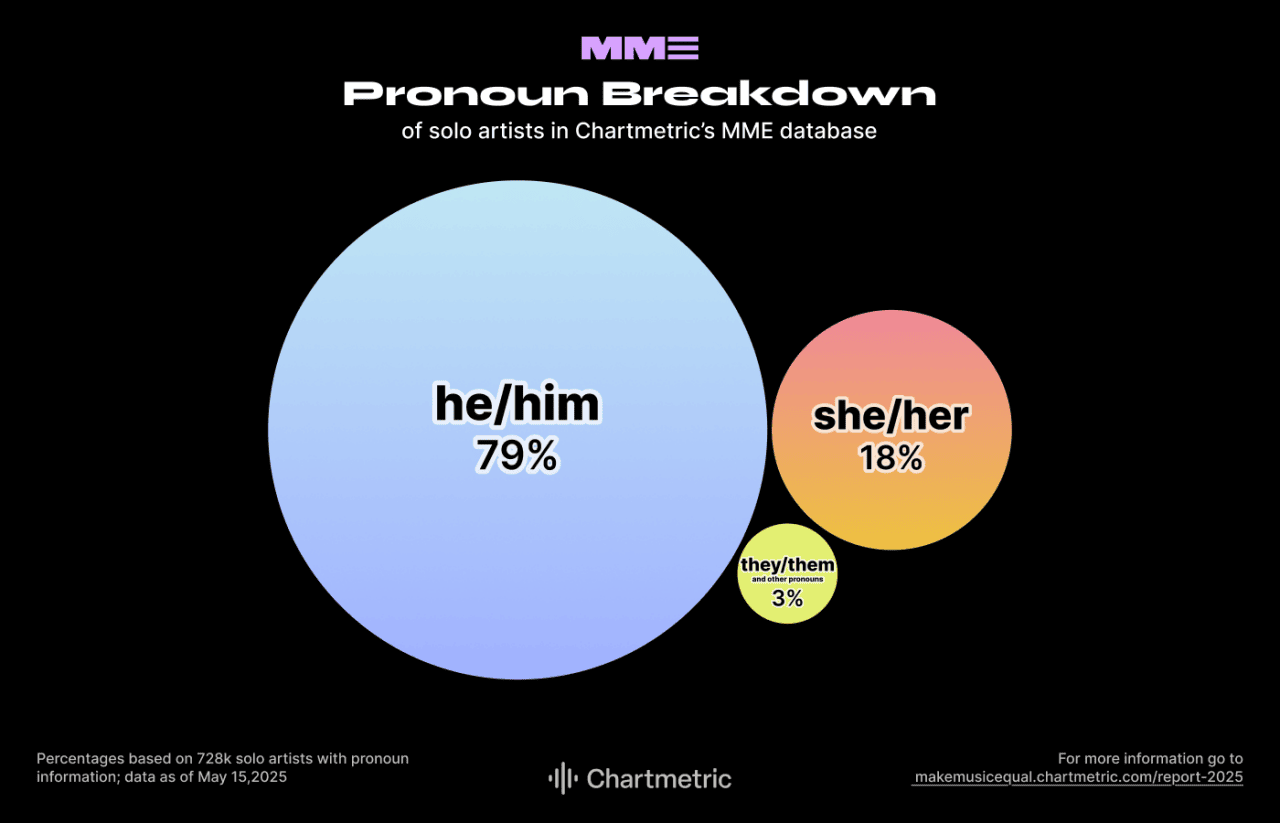
Chartmetric
Across The Industry
Chartmetric has pronoun data on more than 1 million artists from 230 countries and territories.
Of this 1 million, over 728,000 are solo acts. Today, 79% of these solo acts use he/him pronouns, 18% use she/her pronouns and 3% use they/them and other pronouns.
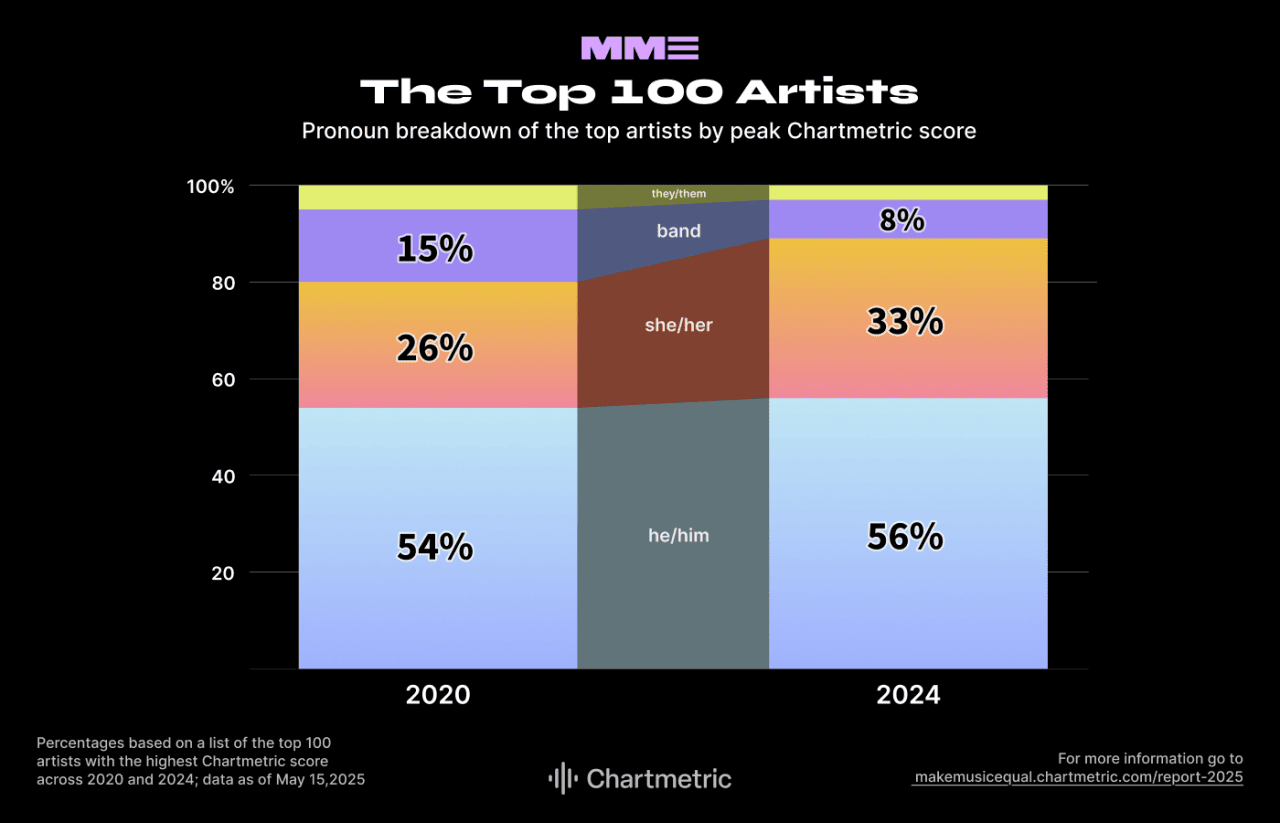
Chartmetric
The Top %
The top 100 artists by peak Chartmetric score are predominantly solo men (54%). However, there are signs of change: Women now make up 33% of this top tier, up from just 26% in 2020.
While the gap remains, the growth signals a shifting landscape where female artists are increasingly breaking into the industry’s most visible and influential ranks. It’s a reminder that change is possible, but also that there’s still work to be done.
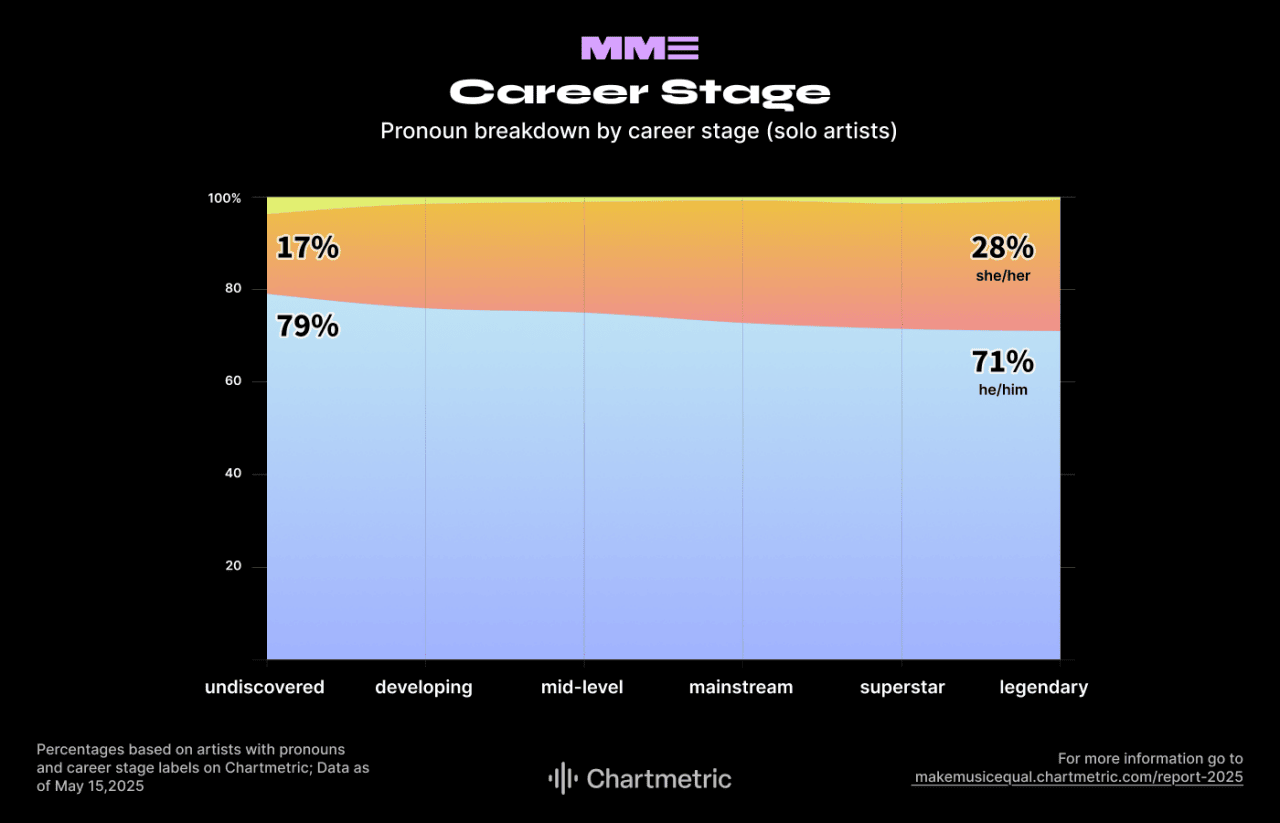
Chartmetric
By Career Stage
As we climb up the career stage ladder, the percentage of solo artists using she/her pronouns increases significantly—from 17% at undiscovered to around 28% for superstar and legendary.
On the other hand, they/them pronouns experience a decline of nearly 5% across stages.
Though men dominate at every stage, women and nonbinary artists are still managing to break through the noise, especially at the undiscovered stage, which accounts for nearly two-thirds of the dataset.
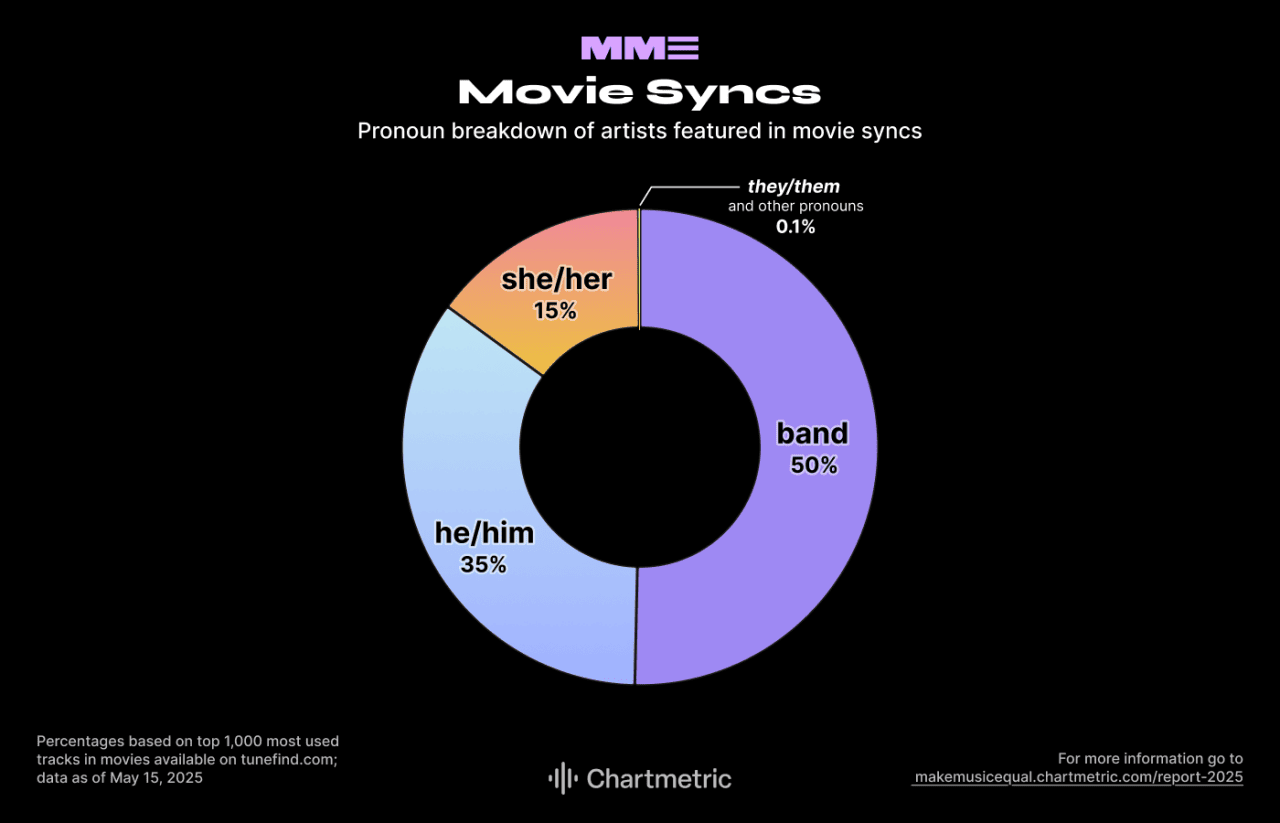
Chartmetric
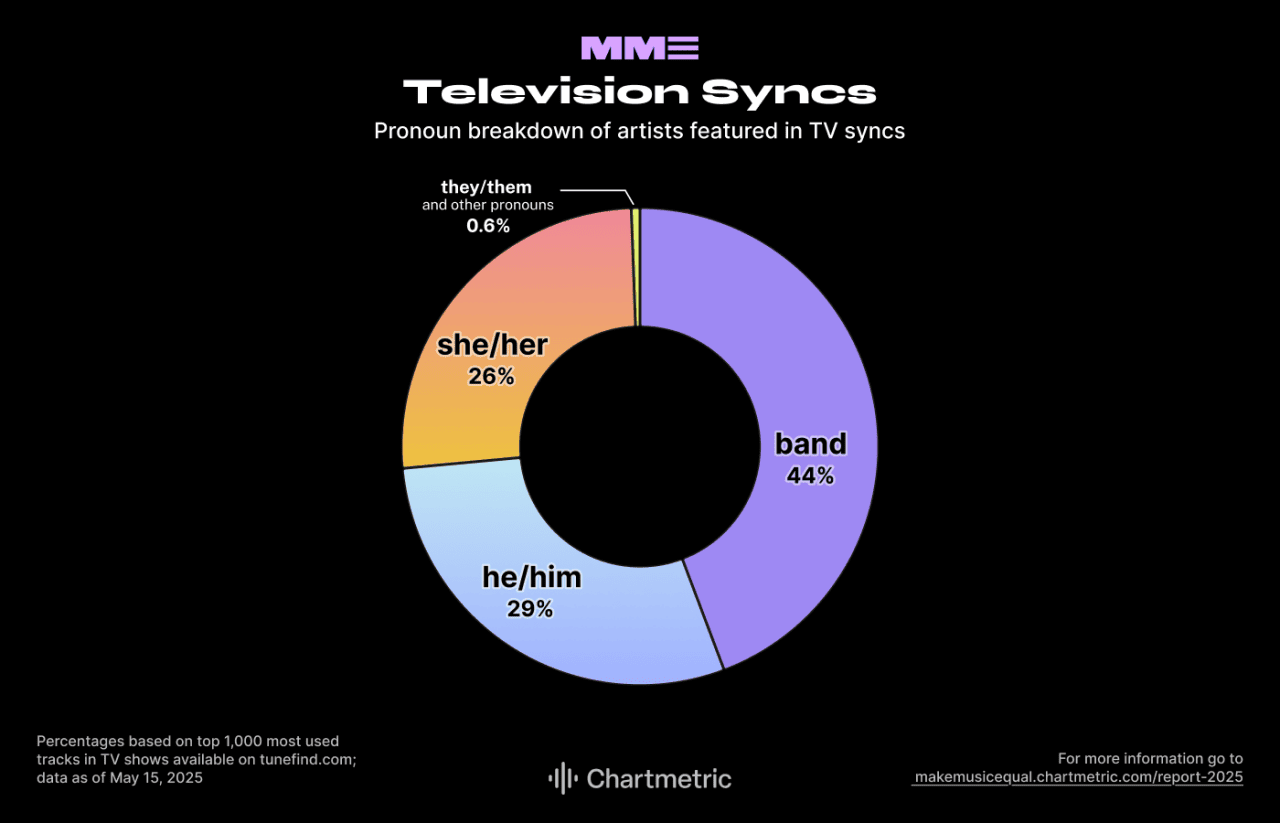
Chartmetric
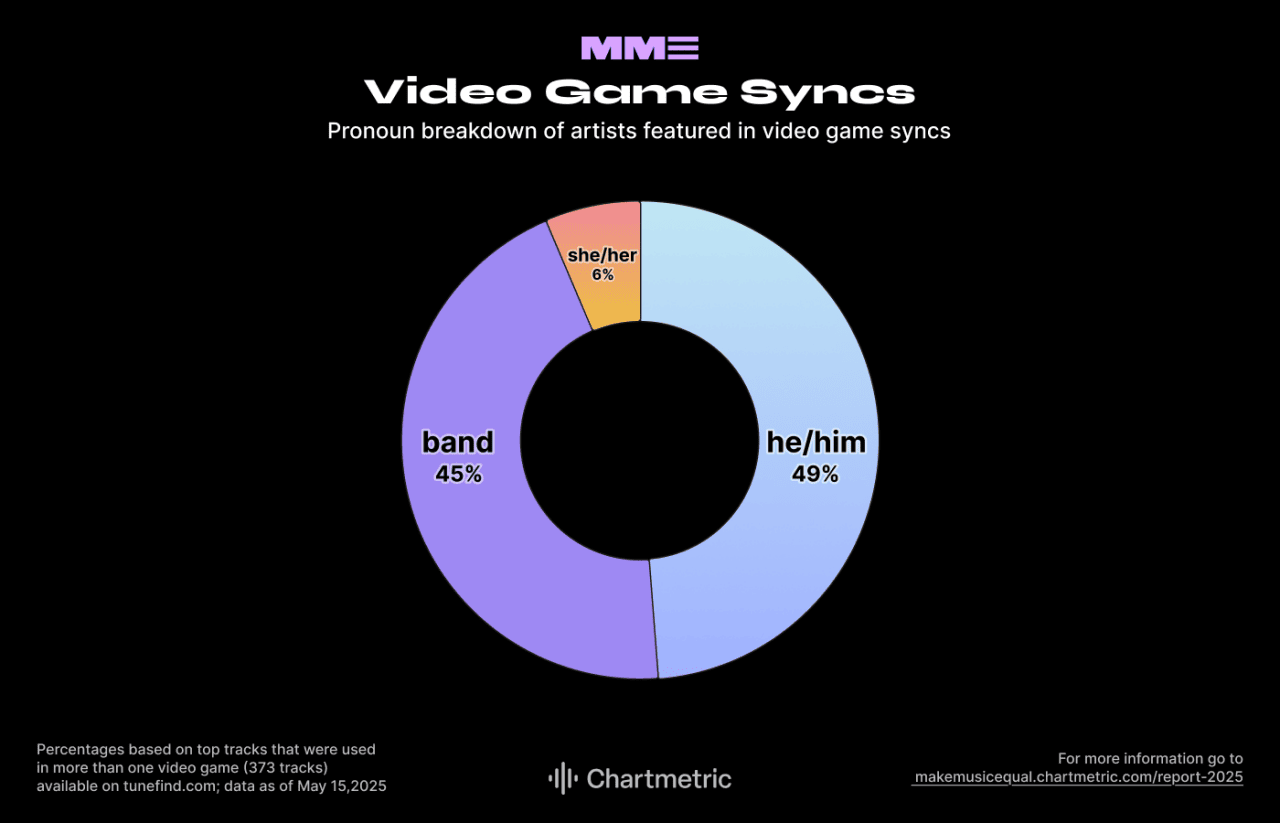
Chartmetric
TV, Movies and Games
Bands dominate the soundtrack of TV: 44% of top-used sync artists are groups. Still, the use of music from men and woman is almost equal at 29% and 26%, respectively.
The most-used movie tracks are by 50% bands, 35% solo men, and 15% solo women. Of the three sync ecosystems, video games show the greatest gender disparity: 49% of featured solo artists are men, while only 6% are women.
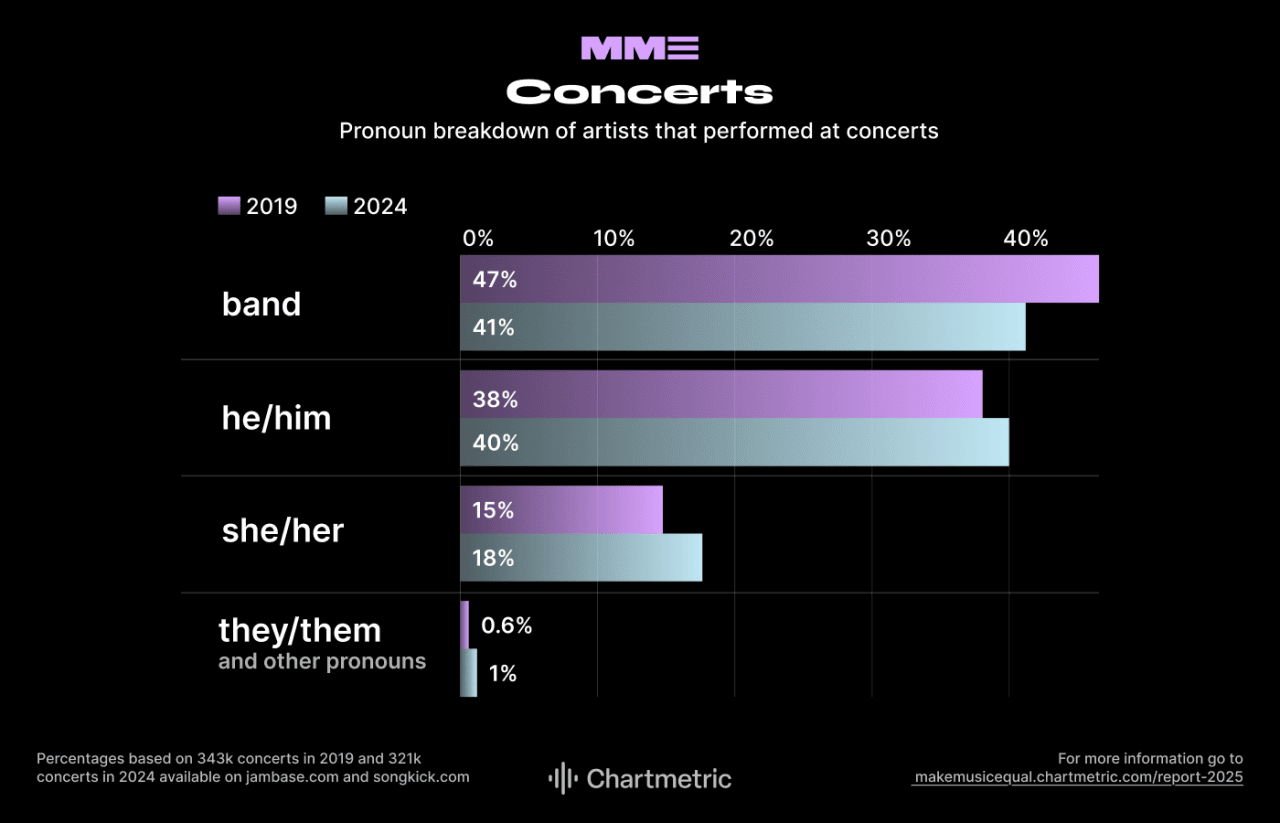
Chartmetric
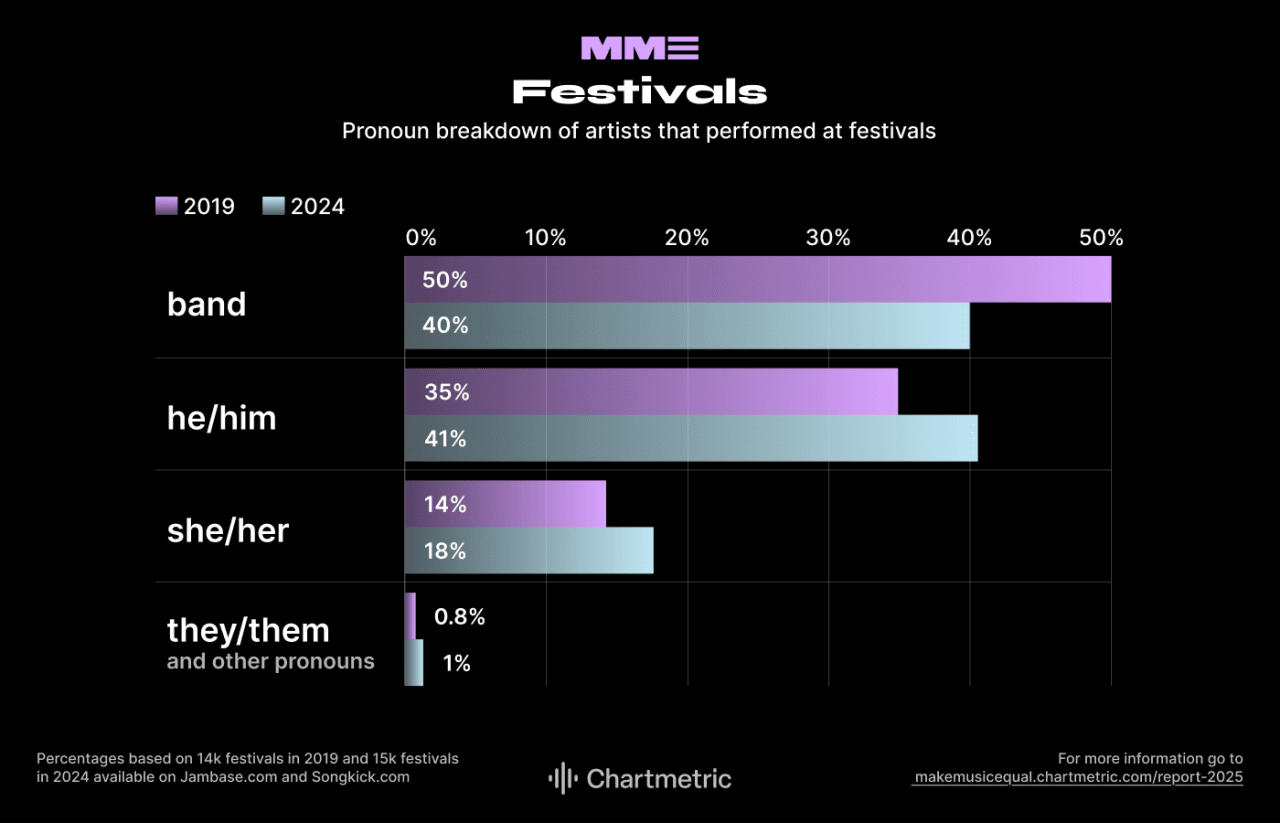
Chartmetric
Concerts and Festivals
The number of she/her artists performing at festivals has risen by 3% since the pre-pandemic era, with he/him acts also seeing a modest 2% increase.
This change appears to be fueled by a notable decline in bands on festival lineups, a trend that aligns with the rising global cost of touring. In today’s tightening economic climate, visibility is becoming more attainable for individual artists, particularly women and nonbinary acts. Similarly, bands used to dominate festival lineups in 2019, but by 2024, their numbers were replaced by solo artists.
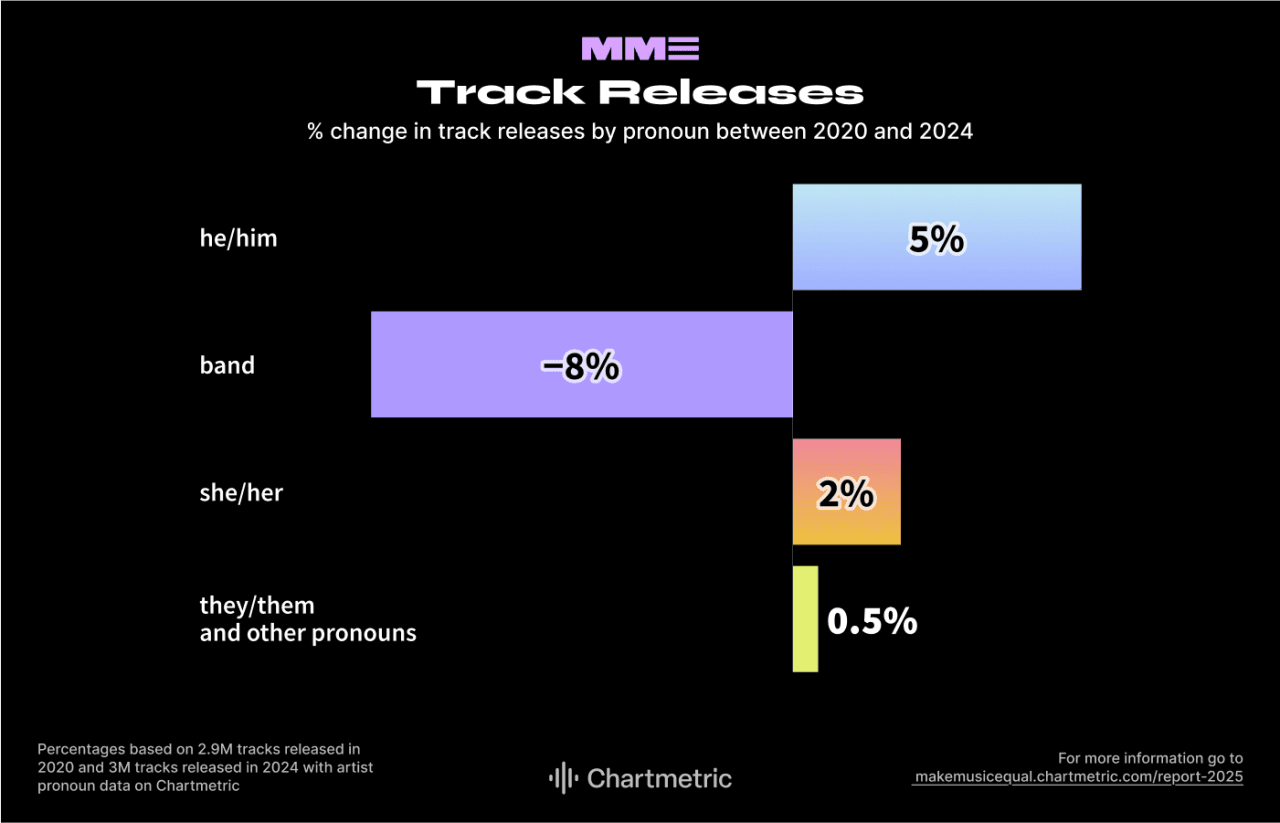
Chartmetric
Track Releases
Tracks released by bands have also decreased by nearly 8%. This has given room for the increase in solo female and male artists, with a rise of 2% and 5%, respectively.
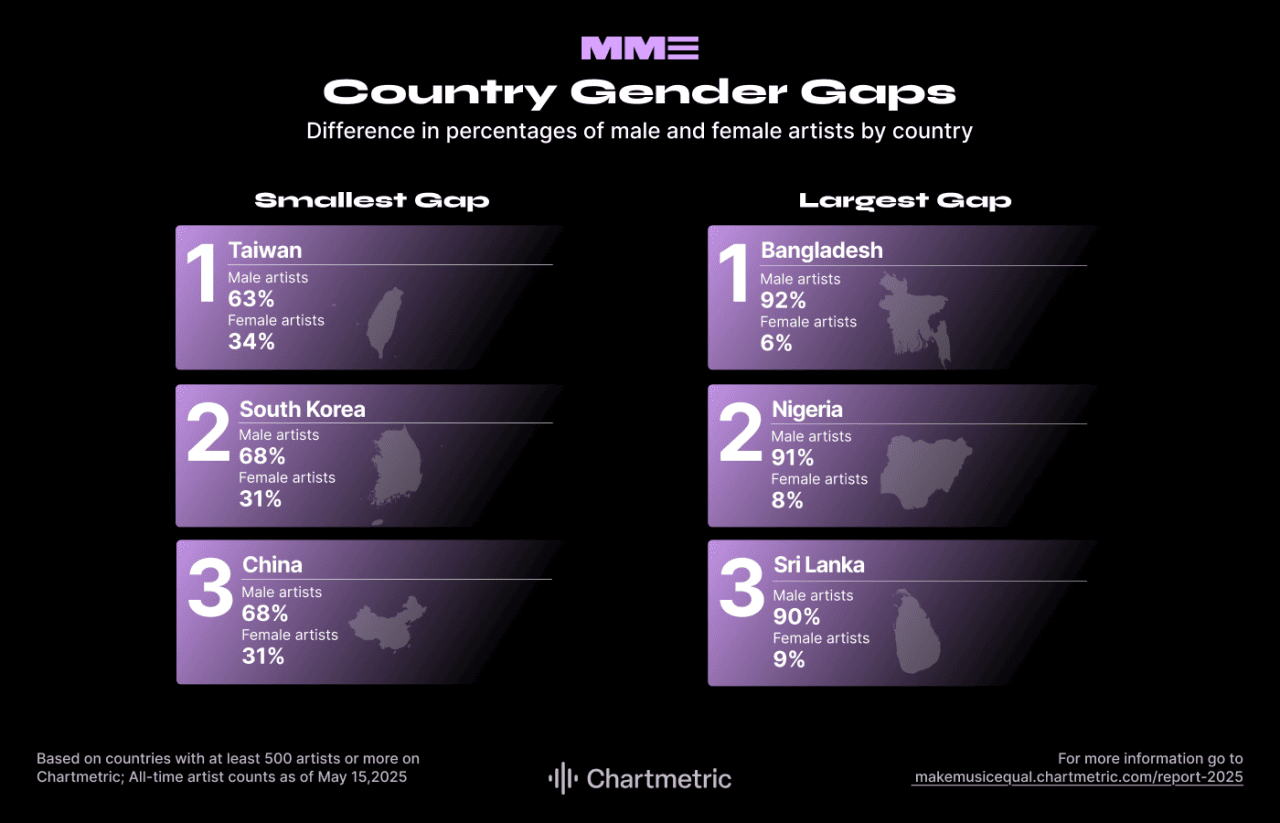
Chartmetric
By Country
Taiwan leads as the country with the smallest gender gap among solo artists—29% more men than women—while Bangladesh sits at the opposite end, with a striking 83% gap favoring male artists.
Though these figures only account for solo male and female artists, the prevalence of solo members from large regional pop groups—such as K-pop or C-pop—may allude to smaller gaps in East Asian countries.
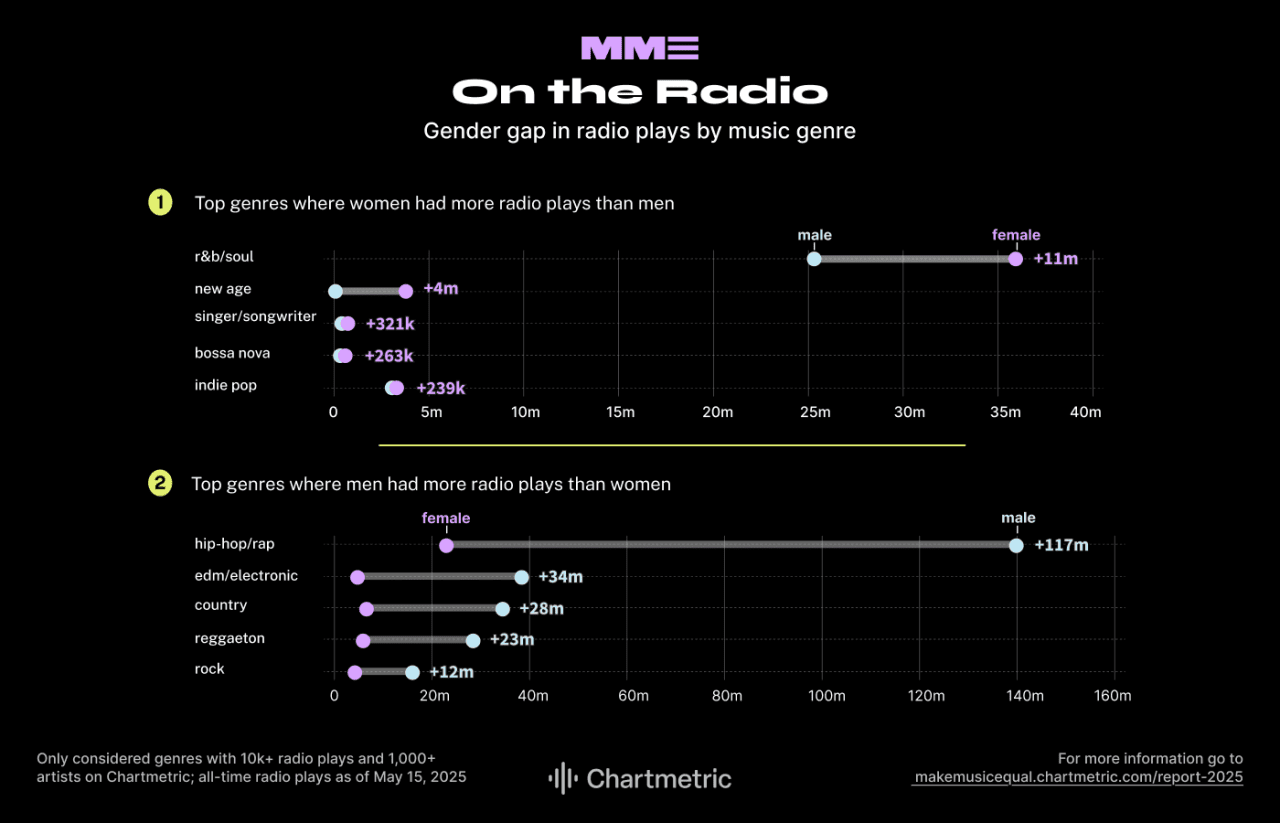
Chartmetric
Radio
Historically, men have often dominated many genres across airwaves, particularly those in country and hip-hop.
Male artists in these genres still experience a significantly greater number of plays than women.
That being said, women are thriving in other genres such as R&B and soul, receiving as many as 11 million times more plays than artists using he/him pronouns. This is likely due to the latest cohort of women in R&B that are ushering in success through authenticity and honesty.
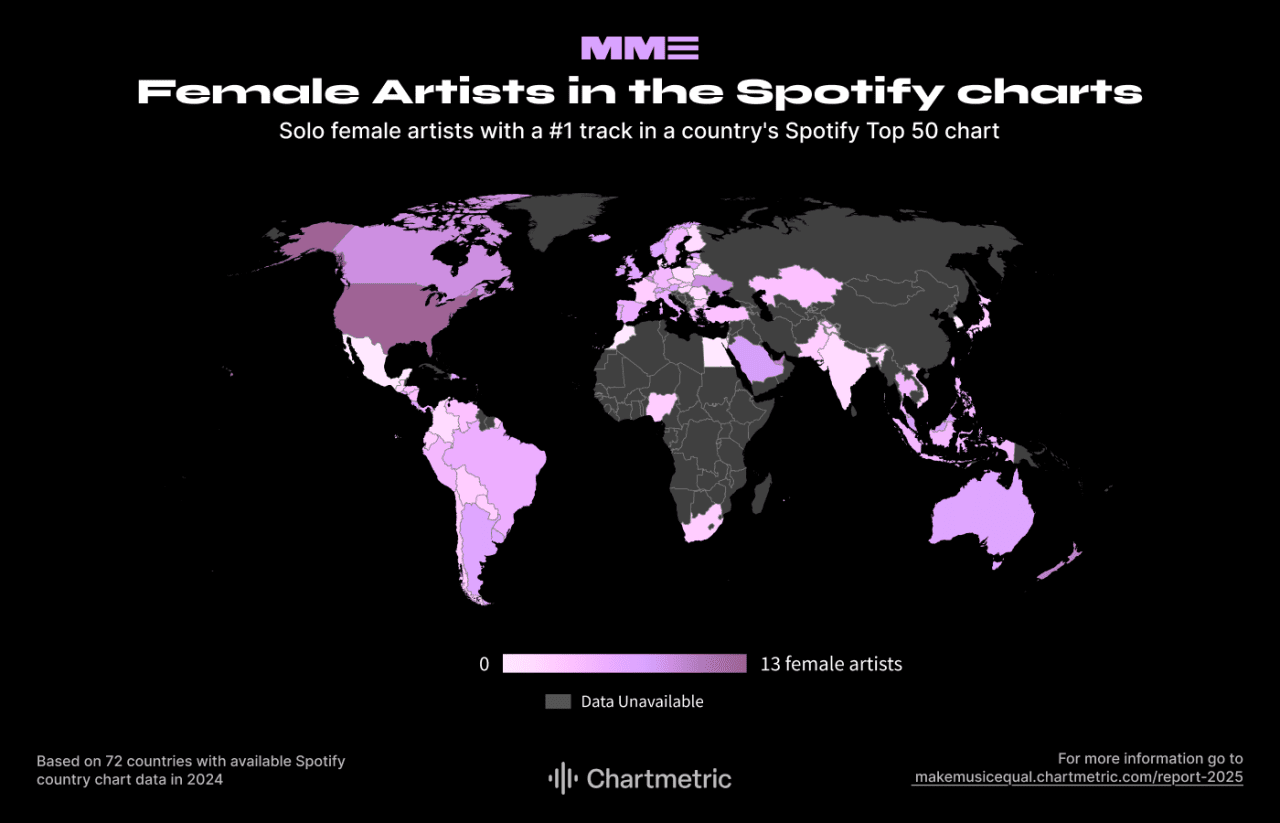
Chartmetric
Top Charts
Women are seeing success in the charts, not only in Western countries, but across the world as well. Though the U.S. leads with 13 female artists who landed a No. 1, an impressive number of countries trail closely: United Arab Emirates (10), Ukraine (9), and Saudi Arabia (8).
Thanks to the recent success of many solo female artists within Latin music, South America also emerges as an impressive scene for women at the top.
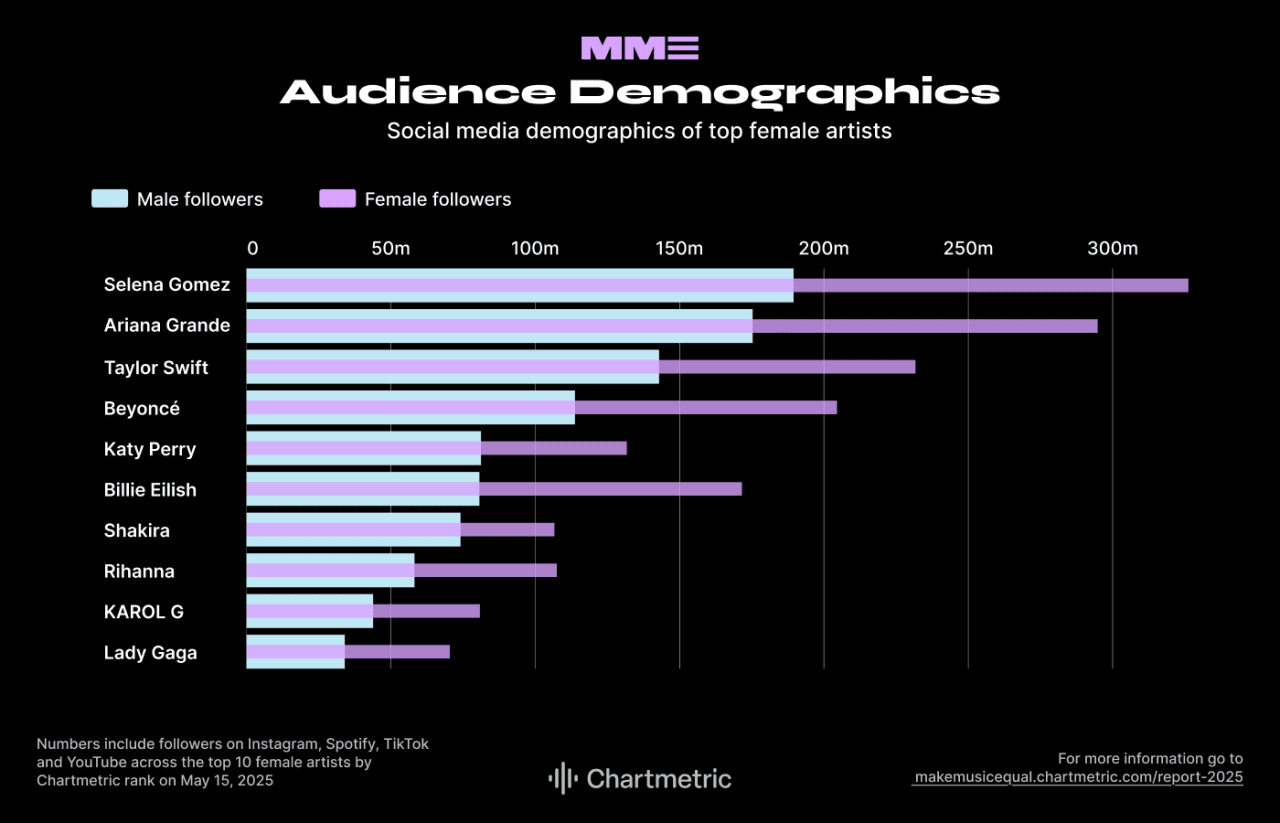
Chartmetric
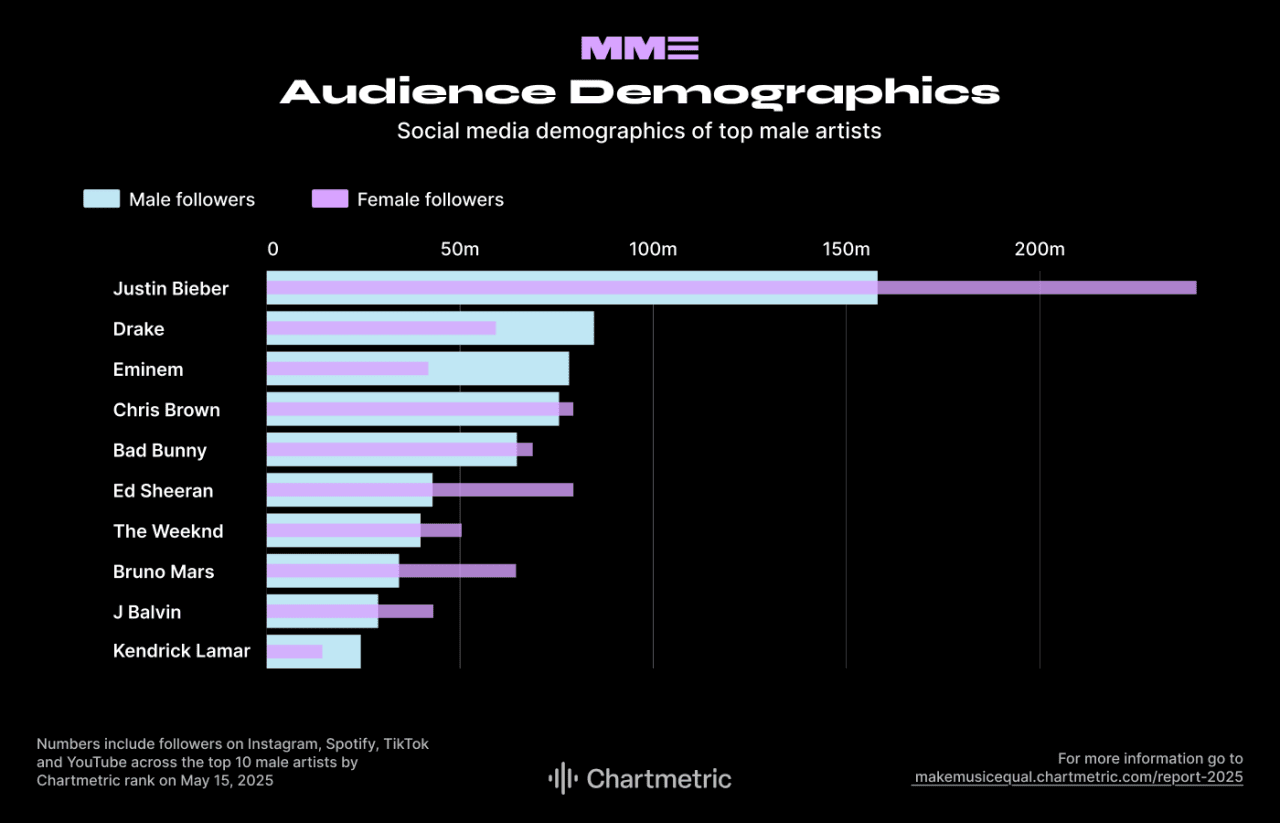
Chartmetric
Social Audience
Among the top 10 male artists by Chartmetric score, female followers outnumbered male followers for all but three: Drake, Eminem, and Kendrick Lamar. Meanwhile, the top 10 female artists saw female fans dominate across the board.
This pattern highlights the strength and consistency of female fandom culture, particularly their roles in driving artist engagement on social platforms. In today’s music economy, where digital presence often fuels career momentum, the loyalty and enthusiasm of female fans continue to shape who rises to—and stays at—the top.
The data in this report paints a layered picture of progress and inequality. While underrepresented groups are gaining visibility across some sectors, longstanding barriers continue to shape who gets heard.
Takeaways:
- Men represent 79% of the dataset, resulting in their dominance across almost every sector.
- Women are breaking through, particularly in the top level of artists, highlighting cultural shifts in the desire for female-fronted content.
- Nonbinary representation has remained stagnant, with an arguable loss of visibility over time.
- The decline of bands is creating space for more solo acts to rise.
- Female fandom fuels success, particularly among top-performing artists.
Why Pronoun Metadata Matters
Pronoun data holds massive potential and equips people with tools to track where progress is happening—and where it isn’t. When artists own their identities, everyone gains a clearer understanding of who is shaping the sounds of today.
Methodology
All pronouns are pulled from public bios on social media and streaming platforms. Due to the dynamic nature of personal identifiers, the pronouns listed may be outdated or incorrect. The report’s authors focus on pronouns because they’re often publicly shared, which helps avoid making assumptions about anyone’s gender identity. Here are additional notes for each section above:
- Across the Industry: Pronoun data is as of May 15, 2025.
- The Top %: Percentages is based on a list of the top 100 artists with the highest Chartmetric score across 2020 and the top 100 artists with the highest Chartmetric score across 2024. Learn more about the Chartmetric score.
- By Career Stage: Percentages based on the number of artists with pronouns and career stage labels on Chartmetric—807,000 undiscovered artists, 114,000 developing, 15,000 midlevel, 8,000 mainstream, 1,319 superstars, and 329 legendary artists as of May 15, 2025. Learn more about career stage definitions.
- TV, Movies and Games: Percentages are based on the top 1,000 most used tracks in TV shows and movies and top tracks used in more than one video game (373) available on tunefind.com as of May 15, 2025.
- Concerts and Festivals: Percentages are based on 343,000 concerts and 14,000 festivals in 2019, and 321,000 concerts and 15,000 festivals in 2024 obtained from Jambase and Songkick.
- Track Releases: Percentages based on 2.9 million tracks released in 2020 and 3 million tracks released in 2024 from artists with pronoun information on Chartmetric.
- By Country: Only countries with over 500 artists on Chartmetric were considered in this ranking. Percentages based on artists from those countries with pronoun data available.
- Radio: Only genres with over 10,000 radio plays and 1,000 artists were considered. All-time radio plays are as of May 15, 2025.
- Top Charts: Only 72 countries with available Spotify country charts in 2024 were considered.
- Social audience: Numbers include followers on Instagram, Spotify, TikTok and YouTube as of May 15, 2025.
This story was produced by Chartmetric and reviewed and distributed by Stacker.
![]()



